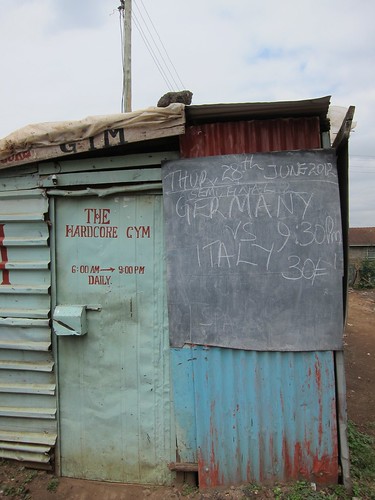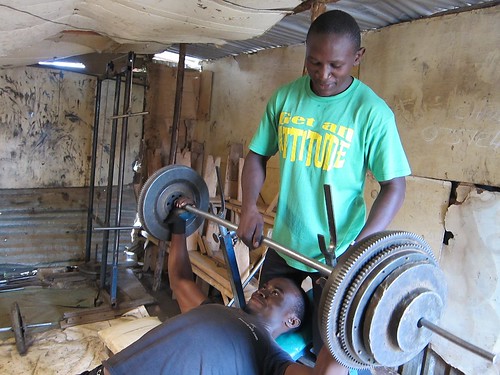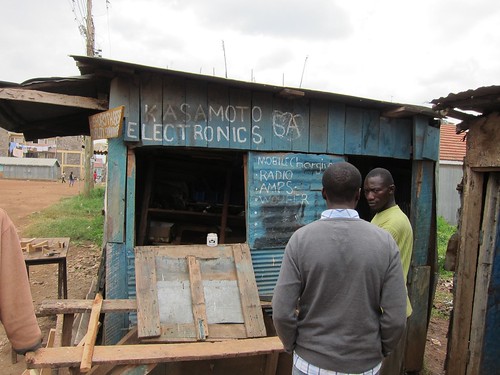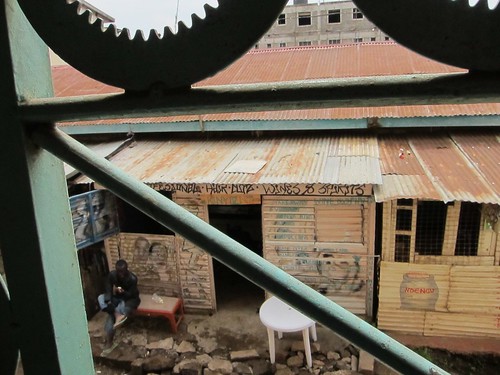I’m discovering that one of my special joys in life is having my presumptions proved wrong.
I’ve just returned from a ten day trip to Kenya, helping host the fifth Global Voices summit, attending board meetings for two companies, and helping my students research an idea we’re playing with at the Media Lab. Our idea is a simple one – we want to help people in nations where electric power is scarce sell power to their neighbors. We’re designing a piece of prototype hardware that plugs into a diesel generator or other power source, distributes the power to multiple outlets, monitors how much power is used and charges the customer for the power they consume.
Kenya is a great place to try this idea out, because it’s got one of the most mature electronic payment infrastructures in the world. Built on top of Safaricom’s mobile phone network, M-PESA is a money transfer system that allows phone users to send payments to one another as an encrypted SMS. If I want to pay my taxi driver 2000Ksh for the ride from downtown to the airport, I can access M-PESA on my phone, enter the size of payment and his mobile number, and he’ll receive an SMS within a few seconds telling him the transaction has been completed. Money comes in and out of the system via thousands of M-PESA dealers, who work in towns of any substantial size, turning money into credit and vice versa.
Because this payment system is used by 70% of Kenyan adults, according to our friends at Safaricom, it makes sense to try to build our power system on top of it. What we’re designing currently looks like a Kill-A-Watt – a unit that monitors energy usage via an ammeter – and a M-PESA-enabled mobile phone. When we build it, it will probably resemble a power strip with a SIM-card slot. Someone who owns a generator can plug our strip in, then invite neighboring shops or homes to run 20-amp power cords to the strip. Each outlet on the strip has a user ID, and the strip itself has an M-PESA ID. To turn on the power, a user sends funds to the power strip’s M-PESA account. The strip monitors usage, sends an SMS to warn a customer when she’s low on power credit and shuts the power off when she’s out of credit.
This might sound clever (or stupid) on paper, but it’s hard to know what works until you actually talk to the people you’d like to use your product. If we were on a research trip designed to focus on this product, we’d have planned trips to a variety of destinations: rural villages, secondary cities, refugee camps. But we were mostly coming to attend the Global Voices conference, so our research was confined to Nairobi. We sought help from our friends at Pawa254, an arts center that works extensively in low-income communities like Mathare, to find guides who could show us their neighborhoods and ask questions about electricity.
And so on our first full day in Kenya, my students Nathan Matias, Matt Stempeck and I found ourselves in a profoundly cramped car, with our new friends Addu and Mike, on Baba Dogo Road. Baba Dogo was intended to be an industrial area on the outskirts of the city, and there are several large manufacturing plants lining the road. But there’s also thousands of people living here, in neighborhoods that have sprung up where land was empty and inexpensive. Baba Dogo isn’t the sort of “famous” slum like Kibera or Mathare – telling some of our Kenyan friends where we’d done our research, they told us we’d been to an “upscale slum”, the sort of distinction that makes sense in a town like Nairobi, where slum tourism is a growth business. Sammi, a musician who lives in the area, led us in on his motorbike, and proceeded to show us around town, talking to the dozens of merchants who ran shops in the area.
Assumption one: I had assumed power would be scarce in Baba Dogo. Nope. Legal power is scarce, but power is extremely common. Kenya Light and Power is quite good about extending the grid into this neighborhood, though few houses are directly connected. Historically, that’s because it was both expensive and time consuming to get a grid connection – friends tell horror stories of connections that cost more than $10,000 and took half a year to get in place. Now connections cost closer to $350 and take only a week… but they’re still way out of reach of ordinary Baba Dogo residents. What usually happens is that a single dwelling within an apartment building has a meter, and they distribute power to their neighbors.

The Hardcore Gym, in Baba Dogo

Pumping iron, in this case, brake drums and gears.
While this system works, it’s hard to say that it works well. Let’s take the example of The Hardcore Gym, a weightlifting gym in a small building made of corrugated iron sheets (where I embarrassed myself by failing to bench press the pile of brake drums and gears this dude is easily lifting…) The gym needs electricity to power a TV and a satellite dish, used to watch major football matches: that night’s Euro Cup semifinal between Italy and Germany was 30Ksh a head, or about $0.40. The gym doesn’t have a formal grid connection, so the proprietor buys power from the house next door, for 200Ksh ($2.50) a month. He doesn’t know whether this is a fair price or not, as neither he or the homeowner can monitor the power he’s using. He lives in some fear that the homeowner won’t pay the bills, and he’ll be left without power – this is pretty common, as a homeowner may be selling power to dozens of people, pushing her bills very high. Sometimes, another businessman told us, the person selling you power disappears, leaving tens of thousands of shilling in debt to Kenya Light and Power and leaving everyone dependent on that power source out of luck.
It isn’t any more fun for the person selling power. You’re forced to collect small sums from dozens of very poor people every month, and if they don’t pay, you’re short of money to pay your own bills. It’s all the trouble of being a landlord, with no legal system to fall back on (as what you’re doing is illegal) and where the safety risk is the strong chance of setting your house on fire. (One popular business in Baba Dogo is metal fabrication, arc welding the ubiquitous gates and safety grills that protect most structures here. Smart welders have their own special circuits negotiated with the power company… but not all are smart, and you can imagine the consequences of plugging a 400 amp arc welder into a cord that’s been attached, makeshift, to a tangle of homemade wiring…)
So, there’s power, but it’s expensive, unpredictable and unreliable. What’s absent from the neighborhood are generators. They’re simply too expensive, even the cheap, dirty Tiger generators that are sold by the hundreds on River Road in Nairobi. The customers for those generators are middle-class Kenyans, looking for backup power when the grid fails, not the residents of Baba Dogo, seeking a primary source of power.

An “electronics store” in Baba Dogo, offering phone charging services
Assumption two: I assumed people would be reluctant to pay for power. And while no one really likes paying for power, people are willing to spend a fairly princely sum charging their mobile phones. In Baba Dogo, powering up your phone involves finding an electronics shop, leaving your phone for an hour or two, and retrieving your phone by paying 20 Ksh for the charge. The sum – about $0.25 – doesn’t sound like much, until you consider that most products and services in this neighborhood are priced for the very poor. Browsing at the neighborhood cybercafe costs half a shilling per minute – $0.40 per hour – and users monitor their time online carefully. A CD filled with mp3s of popular Luo music cost me 50 Ksh, a price that I assume included a fair amount of “tourist tax”.
Here’s a better way to understand comparative cost: a project run by the Danish firm Grundfos is building beautiful, reliable water systems in Kenyan communities that have no access to clean water. Using a clever system that incorporates RFID tags and M-PESA as a payment mechanism, they’re pumping clean well water into a storage tank and selling it to villagers at 2 or 3 Ksh for 20 liters. Some systems aren’t being used to capacity because many villagers aren’t able to pay the $0.03 it costs to fill a large jerry can with water. Instead, they continue to use contaminated water from local streams, a phenomenon that poses an ethical dilemma – should Grundfos simply open the tap and let everyone drink for free, or continue with an experiment that promises a sustainable, clean water source over time?
How does charging a mobile phone become worth as much as 200 liters of clean water?
One brutally simple answer is that customers have an alternative when it comes to purchasing water: they can get dirty water for free. There’s no alternative when it comes to power. Conventional economics suggests that, as power is a commodity, we’d expect to see sharp price competition until vendors were operating on very thin profit margins. Instead, we see power providers settling on a price that seems high to me, but is evidently sufficiently affordable that customers will pay. It’s unclear whether anyone is trying to maintain cartel pricing and punishing defectors, or whether power vendors simply have agreed that 20 shillings is a good price for customers to pay for the service.
Why would customers be willing to pay this much? Phones have become an indispensable infrastructure in the developing world. If you are a carpenter, you probably don’t have an office or a shop – you have a mobile phone number that people call if they want to hire you. If you’re a market trader, you use your phone constantly to figure out what prices are in other parts of a city or the country. If you’re seeking a business permit, you call before you visit an office, so you don’t waste time on transport if the person you need to see is out. Even independent of payment systems like M-PESA, a phone is a difference between being an economic actor in Kenya and being outside the economy.
Which bring us to questionable assumption three: I thought it would be difficult to convince people to think of themselves as becoming micro-scale power companies. Actually, people grasped this idea right away, and wanted to know how much flexibility they would have over pricing. (Answer: we hadn’t really thought about it, but it seems like that’s going to be critical to product success.) People also explained to us that everyone in Baba Dogo is already an entrepreneur of one fashion or another – selling power was a natural extension of existing businesses. But we had to understand that not all commerce in the neighborhood was about the exchange of money for goods or services – often businesses provide favors to one another in complex webs of obligation.

The local liquor store, seen from Sammi’s apartment
We discovered the complexity of these webs when we tried to get a taxi out of the neighborhood. We’d passed a few well-washed, shiny taxis with wooden signs on top that advertised their availability. But when we asked Sammi to help us negotiate with a cab driver, he quickly found someone who lived in his apartment building. His car wasn’t shiny – indeed, the windows didn’t open because the owner was trying to repair the controls, which meant that our ride was unpleasantly sweaty. And we noticed that he wasn’t a very good driver… which he explained by pulling over and picking up his driver, “because I have only been driving for a few weeks, and I am not very good.” So our attempt to hire a taxi turned into hiring a car from a mechanic who was repairing it, and a driver capable of driving it. Why this was an optimal solution, only Sammi knows – it’s possible he shared some of the (extremely high) fare we paid, or that he had other obligations to his neighbors that required us to hire this adhoc taxi, instead of an official one.
The ability to pay with favors as well as with money is something we need to take seriously if we want people to use our product. It’s important, therefore, that we find a way to make our device usable in ways other than pre-paid, so that someone with access to power could loan power to someone who wasn’t able to pay, in exchange for another good, service or favor.
Assumption four: I figured neighborhoods like Baba Dogo would be the right place to try this product out. They’re probably not, as they’re already too well wired. This isn’t to say that there’s no demand for our device in Baba Dogo – I had the sense we could probably sell a few dozen, with Sammi as our local pitchman. (After all, if he can sell me on a taxi ride without windows or a driver, he can surely sell out device.) But it’s likely that the use case in Baba Dogo is to use our meter to share a connection from Kenya Power and Lighting with other users… and it’s quite possible Kenya Power would be unenthusiastic about this use case. (On the other hand, they might welcome this as an alternative to dangerous and adhoc wiring solutions that are already pervasive in high-density neighborhoods.)
Our better use cases are likely in areas where there’s no power other than generator, solar or water power. In some cases, these may be communities where the power grid doesn’t yet extend, but have GSM coverage. In other cases, they may be refugee camps, unlikely to be wired for fear the camps will turn into permanent settlements. There’s something oddly encouraging about discovering that Nairobi’s slums are too advanced for our proposed product – there’s no shortage of other markets where access to power is a major problem and where our solution may prove helpful.
For me, the visit to Baba Dogo – and other visits my students took while we were in Kenya – is a helpful counterbalance to the unlimited possibilities of the Media Lab. I’ve argued for years that culture matters as much as technology when you’re designing new products. Being surrounded by roboticists and synthetic biologists is a great inspiration to look for novel technical inspirations, but it’s worth trying these ideas out in the field early and often. While it’s frustrating to discover that many of my assumptions were wrong in pursuing this project, it would be vastly more frustrating to learn this six months from now, having developed an inappropriate prototype for the wrong market.
More photos from our trip to Baba Dogo. Many thanks to our friends for showing us around their neighborhood, and everyone who was willing to share their thoughts about electric power and microeconomics…
kakuma refugee camp might be a good place to try.
Pingback: Kubatana.net speaks out from Zimbabwe » Blog Archive » Questioning presumptions
Very good idea.
Even for power back-ups in apartment buildings, this would be very welcome. Rural areas too (see http://www.shadaonline.co.ke)
Btw the luo music CD was tourist-tax free
Pingback: Kenya, power and questioning my assumptions | Lukor.net
Pingback: Kenya, power and questioning my assumptions | Lukor.net
Pingback: …My heart’s in Accra » Kenya, power and questioning my assumptions | It's All Social | Scoop.it
Pingback: The Joy of Uprooting (One’s Own) Assumptions | Ethnography Matters
Pingback: Where is he now? MIT Labs with J. Nathan Matias | Davies Jackson Blog
Pingback: The Joy of Uprooting (One’s Own) Assumptions | Ethnography Matters
Comments are closed.